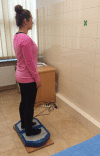Efficacy of Selected Electrical Therapies on Chronic Low Back Pain: A Comparative Clinical Pilot Study
- PMID: 28062862
- PMCID: PMC5240899
- DOI: 10.12659/msm.899461
Efficacy of Selected Electrical Therapies on Chronic Low Back Pain: A Comparative Clinical Pilot Study
Abstract
BACKGROUND In the currently available research publications on electrical therapy of low back pain, generally no control groups or detailed randomization were used, and such studies were often conducted with relatively small groups of patients, based solely on subjective questionnaires and pain assessment scales (lacking measurement methods to objectify the therapeutic progress). The available literature also lacks a comprehensive and large-scale clinical study. The purpose of this study was to assess the effects of treating low back pain using selected electrotherapy methods. The study assesses the influence of individual electrotherapeutic treatments on reduction of pain, improvement of the range of movement in lower section of the spine, and improvement of motor functions and mobility. MATERIAL AND METHODS The 127 patients qualified for the therapy (ultimately, 123 patients completed the study) and assigned to 6 comparison groups: A - conventional TENS, B - acupuncture-like TENS, C - high-voltage electrical stimulation, D - interferential current stimulation, E - diadynamic current, and F - control group. RESULTS The research showed that using electrical stimulation with interferential current penetrating deeper into the tissues results in a significant and more efficient elimination of pain, and an improvement of functional ability of patients suffering from low back pain on the basis of an analysis of both subjective and objective parameters. The TENS currents and high voltage were helpful, but not as effective. The use of diadynamic currents appears to be useless. CONCLUSIONS Selected electrical therapies (interferential current, TENS, and high voltage) appear to be effective in treating chronic low back pain.
Conflict of interest statement
Conflict of interests The authors declare that there is no conflict of interests regarding the publication of this paper.
Figures










Similar articles
-
No immediate analgesic effect of diadynamic current in patients with nonspecific low back pain in comparison to TENS.J Bodyw Mov Ther. 2018 Jul;22(3):693-699. doi: 10.1016/j.jbmt.2017.11.003. Epub 2017 Nov 15. J Bodyw Mov Ther. 2018. PMID: 30100298 Clinical Trial.
-
A pilot study on using acupuncture and transcutaneous electrical nerve stimulation to treat chronic non-specific low back pain.Complement Ther Clin Pract. 2009 Feb;15(1):22-5. doi: 10.1016/j.ctcp.2008.09.003. Epub 2008 Oct 23. Complement Ther Clin Pract. 2009. PMID: 19161950 Clinical Trial.
-
Effects of transcutaneous electrical nerve stimulation (TENS) and interferential currents (IFC) in patients with nonspecific chronic low back pain: randomized clinical trial.Sao Paulo Med J. 2011;129(4):206-16. doi: 10.1590/s1516-31802011000400003. Sao Paulo Med J. 2011. PMID: 21971895 Free PMC article. Clinical Trial.
-
Literature Review and Meta-Analysis of Transcutaneous Electrical Nerve Stimulation in Treating Chronic Back Pain.Reg Anesth Pain Med. 2018 May;43(4):425-433. doi: 10.1097/AAP.0000000000000740. Reg Anesth Pain Med. 2018. PMID: 29394211 Free PMC article.
-
[Electrotherapy].Wien Med Wochenschr. 1994;144(20-21):509-20. Wien Med Wochenschr. 1994. PMID: 7879402 Review. German.
Cited by
-
The Impact on the Stress-Associated Autonomic Response of Physiotherapy Students Receiving Interferential Current in an Electrotherapy Training Session.Int J Environ Res Public Health. 2022 Oct 16;19(20):13348. doi: 10.3390/ijerph192013348. Int J Environ Res Public Health. 2022. PMID: 36293928 Free PMC article. Clinical Trial.
-
Transcutaneous electrical nerve stimulation and interferential current demonstrate similar effects in relieving acute and chronic pain: a systematic review with meta-analysis.Braz J Phys Ther. 2018 Sep-Oct;22(5):347-354. doi: 10.1016/j.bjpt.2017.12.005. Epub 2018 Feb 2. Braz J Phys Ther. 2018. PMID: 29426587 Free PMC article.
-
Pilot study on the effects of low intensity focused ultrasound in a swine model of neuropathic pain.J Neurosurg. 2021 Apr 16;135(5):1508-1515. doi: 10.3171/2020.9.JNS202962. Print 2021 Nov 1. J Neurosurg. 2021. PMID: 33862597 Free PMC article.
-
Baropodometric evaluation of foot load distribution during gait in the group of professionally active nurses.J Occup Health. 2020 Jan;62(1):e12102. doi: 10.1002/1348-9585.12102. Epub 2019 Dec 14. J Occup Health. 2020. PMID: 31837089 Free PMC article.
-
Efficacy of Core Muscle Exercise Combined with Interferential Therapy in Alleviating Chronic Low Back Pain in High-Performance Fighter Pilots: A Randomized Controlled Trial.BMC Public Health. 2024 Mar 5;24(1):700. doi: 10.1186/s12889-024-18177-7. BMC Public Health. 2024. PMID: 38443845 Free PMC article. Clinical Trial.
References
-
- Bilgin S, Temucin CM, Nurlu G, et al. Effects of exercise and electrical stimulation on lumbar stabilization in asymptomatic subjects: A comparative study. J Back Musculoskelet Rehabil. 2013;26:261–66. - PubMed
-
- Delito A, George SZ, Van Dilen L, et al. Low back pain: Clinical practice guidelines linked to the international classification of functioning, disability, and health from the Orthopaedic Section of the American Physical Therapy Association. J Orthop Sports Phys Ther. 2012;42:1–57. - PubMed
Publication types
MeSH terms
LinkOut - more resources
Full Text Sources
Other Literature Sources
Medical

